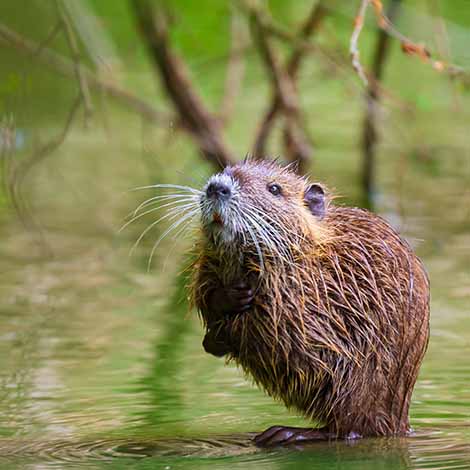The muskrat, scientific name Ondatra Zibethica, is a common critter that's widely distributed throughout North America. This fur-bearing rodent depends on habitats with water - including lakes, rivers, creeks, ponds and marshes - so your visitor could very well be a muskrat. Read on to learn how to identify them and how to prevent these troublemakers from damaging your pond.
Identifying a Muskrat
Weighing only 2 to 4 pounds and measuring 22 to 25 inches (including its nearly hairless, scaly tail that it uses to propel through the water), the muskrat is covered in short, dense fur in shades of brown, grey and blonde. It has relatively small front feet with four major toes and small thumbs. Its hind feet are much larger and partially webbed to assist with swimming.
The small-eyed, small-eared muskrat is classified as a rodent because of its four incisor teeth in the front of its mouth. The two upper and two lower incisors overlap, allowing them to self-sharpen as they are used. Folds of skin behind the incisors allow a submerged muskrat to cut vegetation without getting water into its mouth.
The "musk" part of the critter's moniker derives from musk glands that are predominant beneath the skin on the male's lower abdomen. In the spring, the glands swell and produce a yellowish, musky-smelling fluid.
Home Sweet Home
So what do muskrats look for in a home? They like a spot that includes plenty of food, a body of water and shoreline vegetation. These guys chow on a variety of greens and protein, including roots, stems and buds as well as frogs, snails and fish.
Besides eating cattails and other marginal aquatic plants, muskrats also use their honed teeth to cut down the plants and use them as building materials for their dome-shaped lodges located on stream or pond banks. Muskrat houses are smaller than beaver dens, but they do have one or more underwater entrances. They commonly house an entire family group, which can multiply in a short amount of time.
If you think your pond is home to a growing family of muskrats, look for lodges and burrows made from foliage and mud along the pond bank. Check for their distinctive tracks. And keep an eye out for them at dawn or dusk when they're most active.
Damage Control
Uncontrolled muskrat populations can cause damage to private property and habitat. Their hole digging activities undermine earthen dams, dikes, irrigation canals and farm ponds. Their burrows and shelters may change the direction of water flow into or out of the pond. To rid your pond of muskrats, there are a couple of different techniques.
- Disrupt Their Diet: A muskrat eats aquatic vegetation like cattails, sedges, rushes, water lilies and pond weeds. In some areas, it may also eat clams, mussels, snails, crayfish, small fish and frogs. Keeping your pond clear of excess vegetation such as cattails, grasses, rushes, etc will disrupt a muskrat's diet. The best way to rid your pond of these emergent plants is to use Shoreline Defense Emergent Weed Control & Treatment Booster Plus. Simply mix the two products together in a pond sprayer and spray directly on the target plants. Allow 1-2 weeks for complete control. When the plants are dead (they will turn brown) remove them with the Pond Rake & Cutter. Dead vegetation makes a great nesting area, so be sure to remove it!
- Disrupt Their Environment: Muskrats prefer ponds with four to six feet of still or slow-moving water. Although adding depth to pond may not be a simple option, but adding an Aeration System is. An aeration system will not only provide the circulation needed to deter muskrats but will help to disrupt their diet by reducing weed growth as well.
In addition, try using a Coyote Decoy, Muskrat Live Trap or Nite Guard animal deterrent to scare them away.
